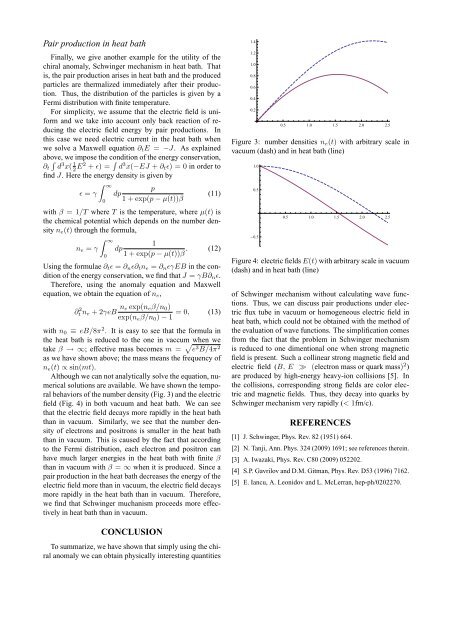Proceedings of International Conference on Physics in ... - KEK
Proceedings of International Conference on Physics in ... - KEK
Proceedings of International Conference on Physics in ... - KEK
Create successful ePaper yourself
Turn your PDF publications into a flip-book with our unique Google optimized e-Paper software.
Pair producti<strong>on</strong> <strong>in</strong> heat bath<br />
F<strong>in</strong>ally, we give another example for the utility <str<strong>on</strong>g>of</str<strong>on</strong>g> the<br />
chiral anomaly, Schw<strong>in</strong>ger mechanism <strong>in</strong> heat bath. That<br />
is, the pair producti<strong>on</strong> arises <strong>in</strong> heat bath and the produced<br />
particles are thermalized immediately after their producti<strong>on</strong>.<br />
Thus, the distributi<strong>on</strong> <str<strong>on</strong>g>of</str<strong>on</strong>g> the particles is given by a<br />
Fermi distributi<strong>on</strong> with f<strong>in</strong>ite temperature.<br />
For simplicity, we assume that the electric field is uniform<br />
and we take <strong>in</strong>to account <strong>on</strong>ly back reacti<strong>on</strong> <str<strong>on</strong>g>of</str<strong>on</strong>g> reduc<strong>in</strong>g<br />
the electric field energy by pair producti<strong>on</strong>s. In<br />
this case we need electric current <strong>in</strong> the heat bath when<br />
we solve a Maxwell equati<strong>on</strong> ∂tE = −J. As expla<strong>in</strong>ed<br />
above, we impose the c<strong>on</strong>diti<strong>on</strong> <str<strong>on</strong>g>of</str<strong>on</strong>g> the energy c<strong>on</strong>servati<strong>on</strong>,<br />
∫<br />
3 1<br />
∂t d x( 2E2 + ϵ) = ∫ d3x(−EJ + ∂tϵ) = 0 <strong>in</strong> order to<br />
f<strong>in</strong>d J. Here the energy density is given by<br />
∫ ∞<br />
p<br />
ϵ = γ dp<br />
(11)<br />
1 + exp(p − µ(t))β<br />
0<br />
with β = 1/T where T is the temperature, where µ(t) is<br />
the chemical potential which depends <strong>on</strong> the number density<br />
ne(t) through the formula,<br />
∫ ∞<br />
1<br />
ne = γ dp<br />
. (12)<br />
1 + exp(p − µ(t))β<br />
0<br />
Us<strong>in</strong>g the formulae ∂tϵ = ∂nϵ∂tne = ∂nϵγEB <strong>in</strong> the c<strong>on</strong>diti<strong>on</strong><br />
<str<strong>on</strong>g>of</str<strong>on</strong>g> the energy c<strong>on</strong>servati<strong>on</strong>, we f<strong>in</strong>d that J = γB∂nϵ.<br />
Therefore, us<strong>in</strong>g the anomaly equati<strong>on</strong> and Maxwell<br />
equati<strong>on</strong>, we obta<strong>in</strong> the equati<strong>on</strong> <str<strong>on</strong>g>of</str<strong>on</strong>g> ne,<br />
∂ 2 t ne + 2γeB ne exp(neβ/n0)<br />
= 0, (13)<br />
exp(neβ/n0) − 1<br />
with n0 ≡ eB/8π 2 . It is easy to see that the formula <strong>in</strong><br />
the heat bath is reduced to the <strong>on</strong>e <strong>in</strong> vaccum when we<br />
take β → ∞; effective mass becomes m = √ e 3 B/4π 2<br />
as we have shown above; the mass means the frequency <str<strong>on</strong>g>of</str<strong>on</strong>g><br />
ne(t) ∝ s<strong>in</strong>(mt).<br />
Although we can not analytically solve the equati<strong>on</strong>, numerical<br />
soluti<strong>on</strong>s are available. We have shown the temporal<br />
behaviors <str<strong>on</strong>g>of</str<strong>on</strong>g> the number density (Fig. 3) and the electric<br />
field (Fig. 4) <strong>in</strong> both vacuum and heat bath. We can see<br />
that the electric field decays more rapidly <strong>in</strong> the heat bath<br />
than <strong>in</strong> vacuum. Similarly, we see that the number density<br />
<str<strong>on</strong>g>of</str<strong>on</strong>g> electr<strong>on</strong>s and positr<strong>on</strong>s is smaller <strong>in</strong> the heat bath<br />
than <strong>in</strong> vacuum. This is caused by the fact that accord<strong>in</strong>g<br />
to the Fermi distributi<strong>on</strong>, each electr<strong>on</strong> and positr<strong>on</strong> can<br />
have much larger energies <strong>in</strong> the heat bath with f<strong>in</strong>ite β<br />
than <strong>in</strong> vacuum with β = ∞ when it is produced. S<strong>in</strong>ce a<br />
pair producti<strong>on</strong> <strong>in</strong> the heat bath decreases the energy <str<strong>on</strong>g>of</str<strong>on</strong>g> the<br />
electric field more than <strong>in</strong> vacuum, the electric field decays<br />
more rapidly <strong>in</strong> the heat bath than <strong>in</strong> vacuum. Therefore,<br />
we f<strong>in</strong>d that Schw<strong>in</strong>ger muchanism proceeds more effectively<br />
<strong>in</strong> heat bath than <strong>in</strong> vacuum.<br />
CONCLUSION<br />
To summarize, we have shown that simply us<strong>in</strong>g the chiral<br />
anomaly we can obta<strong>in</strong> physically <strong>in</strong>terest<strong>in</strong>g quantities<br />
1.4<br />
1.2<br />
1.0<br />
0.8<br />
0.6<br />
0.4<br />
0.2<br />
0.5 1.0 1.5 2.0 2.5<br />
Figure 3: number densities ne(t) with arbitrary scale <strong>in</strong><br />
vacuum (dash) and <strong>in</strong> heat bath (l<strong>in</strong>e)<br />
1.0<br />
0.5<br />
0.5<br />
0.5 1.0 1.5 2.0 2.5<br />
Figure 4: electric fields E(t) with arbitrary scale <strong>in</strong> vacuum<br />
(dash) and <strong>in</strong> heat bath (l<strong>in</strong>e)<br />
<str<strong>on</strong>g>of</str<strong>on</strong>g> Schw<strong>in</strong>ger mechanism without calculat<strong>in</strong>g wave functi<strong>on</strong>s.<br />
Thus, we can discuss pair producti<strong>on</strong>s under electric<br />
flux tube <strong>in</strong> vacuum or homogeneous electric field <strong>in</strong><br />
heat bath, which could not be obta<strong>in</strong>ed with the method <str<strong>on</strong>g>of</str<strong>on</strong>g><br />
the evaluati<strong>on</strong> <str<strong>on</strong>g>of</str<strong>on</strong>g> wave functi<strong>on</strong>s. The simplificati<strong>on</strong> comes<br />
from the fact that the problem <strong>in</strong> Schw<strong>in</strong>ger mechanism<br />
is reduced to <strong>on</strong>e dimenti<strong>on</strong>al <strong>on</strong>e when str<strong>on</strong>g magnetic<br />
field is present. Such a coll<strong>in</strong>ear str<strong>on</strong>g magnetic field and<br />
electric field (B, E ≫ (electr<strong>on</strong> mass or quark mass) 2 )<br />
are produced by high-energy heavy-i<strong>on</strong> collisi<strong>on</strong>s [5]. In<br />
the collisi<strong>on</strong>s, corresp<strong>on</strong>d<strong>in</strong>g str<strong>on</strong>g fields are color electric<br />
and magnetic fields. Thus, they decay <strong>in</strong>to quarks by<br />
Schw<strong>in</strong>ger mechanism very rapidly (< 1fm/c).<br />
REFERENCES<br />
[1] J. Schw<strong>in</strong>ger, Phys. Rev. 82 (1951) 664.<br />
[2] N. Tanji, Ann. Phys. 324 (2009) 1691; see references there<strong>in</strong>.<br />
[3] A. Iwazaki, Phys. Rev. C80 (2009) 052202.<br />
[4] S.P. Gavrilov and D.M. Gitman, Phys. Rev. D53 (1996) 7162.<br />
[5] E. Iancu, A. Le<strong>on</strong>idov and L. McLerran, hep-ph/0202270.













